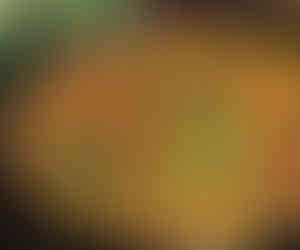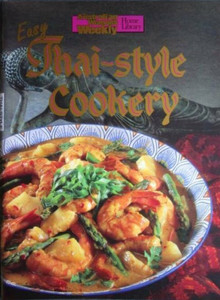Curry from the jungle - a lucky dip
- rosemary
- Apr 26, 2022
- 6 min read
The dish shown above is not Jungle curry. It is a dish called Pork curry with eggplant from an old Women's Weekly booklet Easy Thai-Style Cookery (1991) - my current lucky dip book and recipe. It's been sitting on my desk for ages, so time to tackle it. Particularly as we have been talking about curries of late.
I bought this book at a time when I was enraptured with Thai cooking, from a couple of short visits to Thailand, and from dining in a few Thai restaurants. I loved Thai food, although it was often somewhat hot but somehow it was more delicate than Indian food. I also bought Charmaine Solomon's Thai Cookbook. I had tried a David Thompson book (more about him later) but had found it just too complicated and requiring so many ingredients that were just not available at that time. Some of them still aren't. Well not easily anyway. So finding these two books was an absolute boon. Charmaine Solomon purports to be 'authentic' but The Women's Weekly makes no such claim, saying in its very brief introduction:
"These 82 recipes have been modified and simplified - we don't claim that they are true-blue Thai!"
It's yet another book that should be used more often, although then again probably not because Thai food is (a) hot and (b) mostly includes coconut milk. And we all know by now that this is verboten in this household.
This particular recipe is dead simple - just make your curry paste - they tell you how. It is just a blender job and can be made in advance, cook the paste with the coconut milk for a bit, add your pork, and then your vegetables and cook. Simple.

What more was there to say, except give it a go if you can handle chilli and coconut milk? So I started looking for similar recipes and rapidly found that the pork and eggplant combination was a very common one for something called Jungle curry. I think the first version I found - which looked delectable was Jungle curry with pork and Thai eggplant from Epicurious. And here I discovered that it was called Jungle curry because it comes from the north of Thailand where there are jungles, and no coconut palms, because the climate is too temperate, so it's different from the standard kind of Thai curry.
To be fair to The Women's Weekly they make no claim that this is a Jungle curry. It's just a curry for which they have suggested using pork and eggplant, which was really the thing that led me to the jungle. As I investigated further though I discovered that it's called 'gaeng pa'. and that it is made with water or chicken stock rather than the coconut milk, any vegetable that is available at the time, originally from jungle game, such as wild boar, and that it is much more liquid than either of the two recipes above:
“Gaeng pa is a generic term for a curry without coconut milk, but it’s really more of a soup than a curry ... It’s very rustic, made with stock and whatever veggies are in season at the time.” Palisa Anderson/SBS
- and yes there are lots of chillies - even the Thais think it is hot.
"There is one firm rule when it comes to making gaeng pa, however: "By definition, you’re making something that’s going to completely blow your head off,” she says. She’s talking about the chilli – so don’t hold back." Palisa Anderson/SBS
The best and fullest explanation I found about the genre - if that's the right word to use - was from that article on the SBS website which springs from Maeve O'Meara's book Food Safari - Water. It's called Less coconut, more chilli and is written by Lucy Rennick with lots of input from Palisa Anderson who is a Sydney Thai chef.

Elsewhere on SBS there is a recipe for Jungle curry with pork (Gang bap moo) from Sareen Rojanemetin & Jean Thanmthanakorn which also includes those eggplants - the small round ones seem to be the thing - and this one does look a bit more authentically runny.
I mentioned David Thompson earlier and his book that I eventually threw out - well gave to an op shop. However, just a week or so ago his most famous tome - a different one to the one I had back then - which is simply called Thai Food and which has come to be considered the Thai food bible I think, with Thompson as the high priest of all things Thai - appeared in our street library. So I grabbed it. Here is what he says about Jungle curries:
"A jungle curry is a very hot style of curry, as the heat of the chilli is not mitigated by the sweet richness of coconut cream. Jungle curries are favoured by people living outside major towns because they use ingredients that are easy to find, and the preparation takes merely a few minutes. Only a small amount of oil should be used, just enough to fry the paste, for a jungle curry is not an oily curry - any extra oil would swamp the dish, inhibiting its immediate pungency and thus its distinguishing qualities.
A jungle curry is usually seasoned only with fish sauce or its rustic forebear, fermented fish sauce, and perhaps a pinch of sugar. A wet curry, it is then moistened with stock - never coconut milk - and the end result should be a sharp, hot, salty and pungent curry. Rarely do jungle curries include dried spices - in fact I have never come across them in a recipe, apart from the occasional peppercorn. The most common jungle curries contain a variety of vegetables; this gives texture and flavour to the curry, preventing it from being just searingly hot. ... Jungle curries are usually perfumed with torn kaffir lime leaves and finished with holy basil."

There you have words from on high as far as Thai food goes, and here is his Jungle curry of fish with deep fried shallots which the writer of a website called Hungry Planet made, and of which he or she wrote:
"It was a little like a runaway freight train. Once that flame was burning under the wok there was a quick succession of ingredient additions and you were done. No time to contemplate the flavours. ... Overall I enjoyed it but the flavours were a little mellow, it didn't have that pop that other David Thompson curries I have made offer." Hungry Planet
'No pop' - with all that chilli - 10-15 green bird's eye chillies? Aren't they the really hot ones? The fish by the way, being from the north of Thailand is river fish, and it does look lovely, though The Hungry Planet guy or girl was a bit dissatisfied with their version.

None of Thompson's recipes are dead simple but they're not that complicated either. They are within my level of expertise on a good dayI think. However, have a look at this beautiful version of Jungle curry which features fish again - cured kingfish and pippis to be precise. It's from chef Benjamin Cooper who demonstrated it on Master Chef. The recipe goes on for ever and has so many different complicated steps to it. Definitely one for those who have nothing better to do. And you have to ask how come a dish that originated from the poorest of the poor who tend to cook simply because they have neither the ingredients, the equipment nor the time to do otherwise, how does it come to be a recipe that takes hours of fiddly processing, expensive ingredients and cheffy techniques? Is that progress, or is it not?
Fortunately there are others out there who take the middle road - reasonably authentic but simple with the occasional forbidden addition of coconut milk or cream or a shortcut - like a jar of jungle curry paste - Charmaine Solomon has one. There are actually heaps of recipes on the net - here are just a few: Thai jungle curry from Chiang Mai from Darlene Schmidt of The Spruce Eats; Thai jungle curry / Dan Toombs - The Curry Guy; Green chicken jungle curry / Rodney Dunn - Taste; and Pork and eggplant jungle curry / Alison Adams also from Taste. And, as you can see with varying degrees of authenticity as far as liquid goes and also colour. Green doesn't really seem to be a common thing.
Now I could try the original Women's Weekly recipe which doesn't have hot chillies - just sliced red and green ones. Well I guess you could use as hot as you like. And there are also, some spices like turmeric, paprika and cumin as well as coconut milk - oh no - no can do.
Or I could try the recipe on the previous page - Dry beef curry with onions and peanuts - well if it wasn't for the coconut milk. Maybe I should put this in the street library as well, as there's probably not much in there that I can actually make for David.












Comments